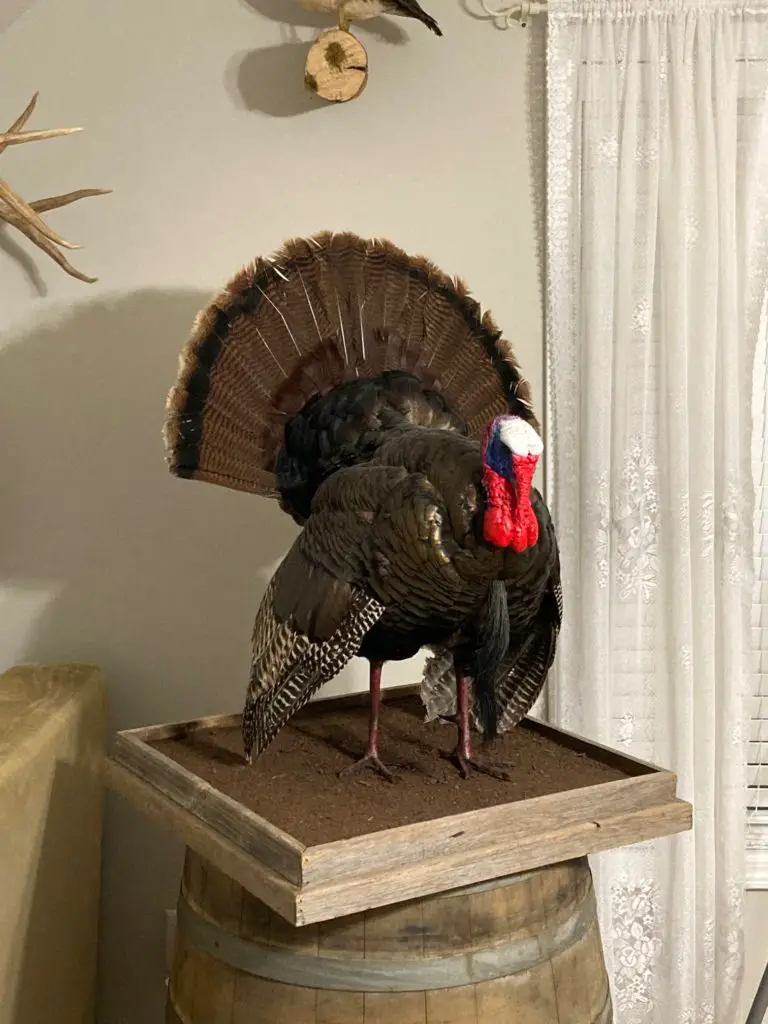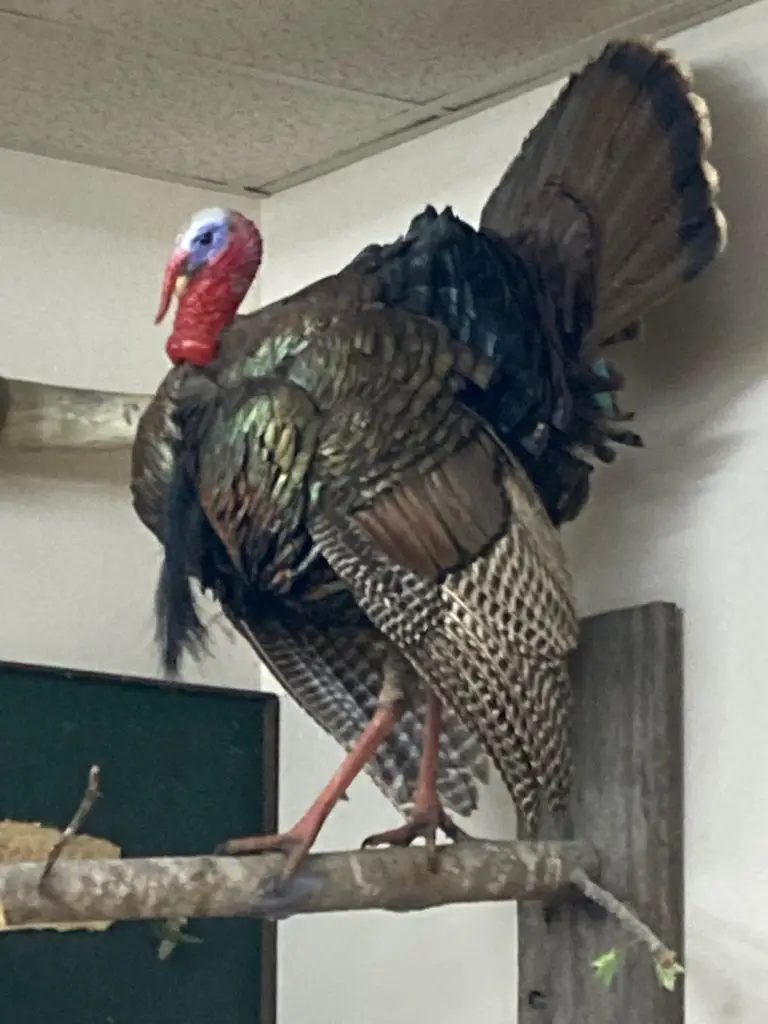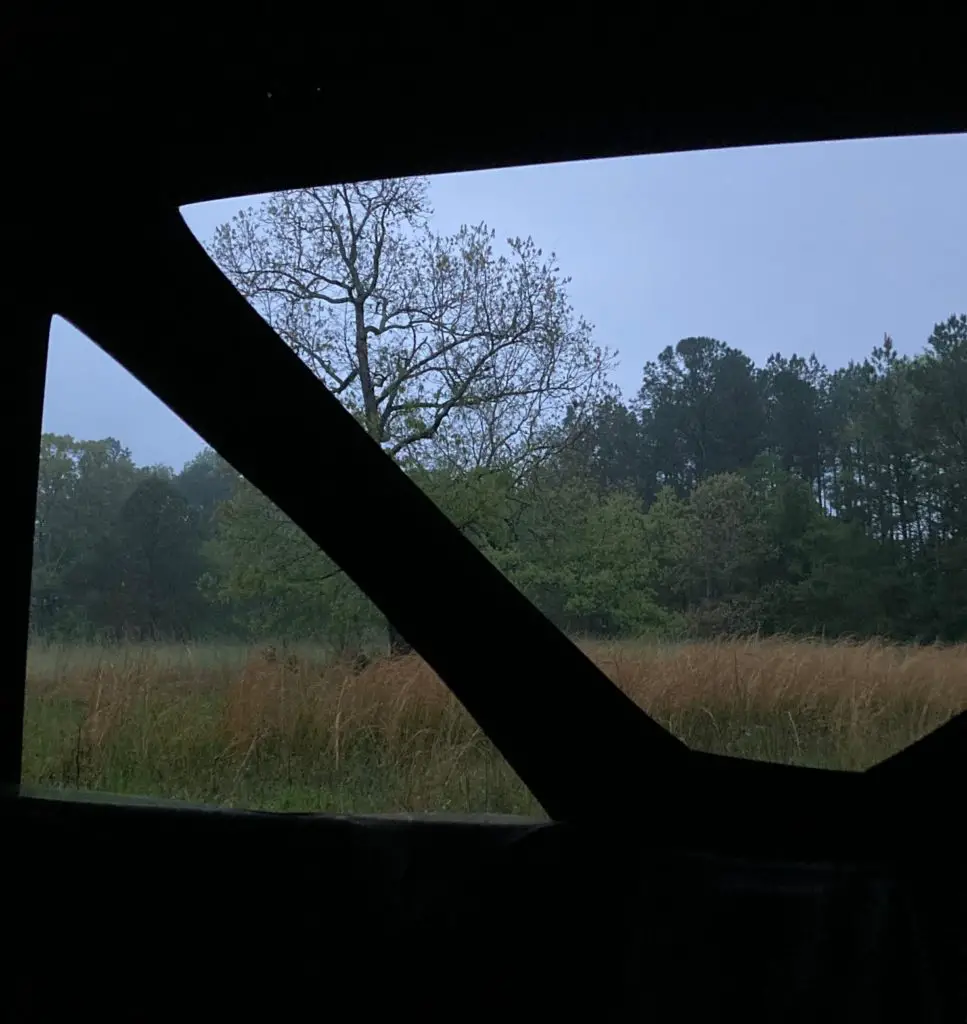
You did it! You finally sealed the deal on a longbeard.
You set the bird up just right for a picture. You measure his beard, his spurs. You text all your buddies. But now what? How do you get the bird that is in the back of your truck onto your wall?
Read on as we discuss turkey taxidermy. We’ll cover how to care for, prepare, store and transport your kill. We’ll talk about how to pick the right taxidermist. Finally, we’ll discuss what pose your gobbler would look best in.
Caring For Your Turkey After the Kill
A turkey only has one set of feathers. The more feathers damaged, the more difficult you will make it for your taxidermist. Feathers lost in the field, damaged, or blood-stained will present challenges when creating a quality mount.
Let’s back up to the time before you took the shot. How can you ethically kill this turkey without damaging it too much?
For starters, don’t shoot at a bird in strut. You are likely to hit and damage more feathers when the bird’s feathers are fluffed up around his vitals. Wait for him to come out of the strut and poke his head up. Then go for the headshot.
Once he hits the ground and starts flopping, get to him! The flop can be extremely damaging to feathers so try to get a boot on his head. Be cognizant of his spurs which can cause serious damage to human flesh.
After he goes still, enjoy the moment. You have some time to appreciate the hunt and the gobbler’s life. Let his body start to cool naturally.
Ideally, contact your taxidermist at this point and ask him for his recommendations. If this is not possible, here’s what you should do.
Reduce friction on the turkey as much as possible. If blood is dripping, try to dry the blood. Clean any blood off that you can. You may even consider putting a bag over the bird’s head if it is pouring blood onto the rest of the body.
Consider using a turkey tote to get your turkey to the truck. There is generally less feather damage when a tote is used around the turkey’s feet than when you carry him in your vest.
The faster you can get him to your taxidermist, the better. If you can’t get there for several hours, first let him cool for about an hour. Then, stick him in a plastic garbage bag and put him in the freezer. He can stay like this for an extended period of time.
Try not to bend the bird unnaturally in the freezer if possible.
If you can’t get the bird to the taxidermist or freezer within a few hours, you may need to gut him. In a perfect world, you would never touch this turkey with a knife yourself, but the world ain’t perfect.
You may not be able to keep the breast meat to eat if you choose to mount your turkey. Keep this in mind as you are choosing what to do. There are some taxidermists who can mount the bird and get you the breast meat. Once again, it’s best to discuss this ahead of time with your taxidermist.
Selecting a Turkey Taxidermist
If you have no idea where to start in finding a taxidermist, Google is your friend. Search for “taxidermist near me.”
Once you have a few candidates, visit their websites. Do they have any pictures of turkey taxidermy? How does it look? Do they list their prices? Does the price fit your budget?
Now Google the name of the taxidermist. You are looking for reviews and critiques on forums. See if you can find anything good or bad about the taxidermist written on the internet.
Now call the taxidermist. Ask him what his turnaround time is. Verify his prices. See if you can visit his shop to look at some mounts of his. Get references and call them.
If you can go to the shop, take a look at his mounts. Do they look real? Would you be happy having them in your home? If so, you are on the right track. If not, thank the taxidermist for his time and ghost him like the girl who asked you to meet her parents after the first date.
Turkey taxidermy is different than deer taxidermy. Many amateurs and beginning taxidermists can mount mammals with a reasonable degree of realism. But when it comes to birds, that’s a whole different ballgame. Ask your taxidermist about his experience with turkey taxidermy.
Jason Brooks with the Outdoor Line recommends asking your taxidermist what they subcontract. While a shop may handle its own deer or fish, it may ship out birds or other animals to other shops. It’s better to know as much information on this as you can get.
Beware the taxidermist who charges way less than his competitors. You may not get what you are hoping for in your mount. The best turkey taxidermists will be in high demand and will likely command a higher price for their services.

The Best Poses for your Turkey Taxidermy
The best pose for turkey taxidermy is certainly subjective. It also can vary based on the specimen you kill and the damage it sustains during the kill and transport. The amount and type of space you have for display can also play a part in the pose you choose.
I recommend having a first-choice and second-choice pose before you get to the taxidermist. Your taxidermist may look at your gobbler and determine that damage to certain areas will not make one pose or another a good option.
I always like to show the taxidermist a picture of what I’m looking for. Search “turkey mounts” in Google Images and find one that you like. Make sure that the taxidermist feels comfortable with this choice. Also, verify the price for this particular pose.
Different poses show a turkey off in different ways. If you shoot a turkey with a paintbrush for a beard, a full strut, gobbling on the limb, or flying (breast out) pose would do a good job highlighting this feature.
A full strut pose is really cool for Merriam’s or Gould’s turkeys which have white/buff-colored tips on the tail fan. A flying (back out) pose displays the plumage of a gobbler really well too.
A bird with long spurs might look great in a dead-hang pose or a gobbling on the limb pose. If you happen to have multiple gobblers, a fighting pose also shows off those hooks.
Another consideration when choosing a pose is where you will put your finished turkey taxidermy. If space is limited, choose a pose that mounts on the wall. Have a good display table, or better yet, a whiskey barrel? Consider putting a gobbler in full strut on it.
If you eventually plan to mount multiple birds (such as all the species of a grand slam), think about a pose that can easily be incorporated into a larger display.




Pingback: Why Hunters Love Turkey Spurs - Strutting Tom.com